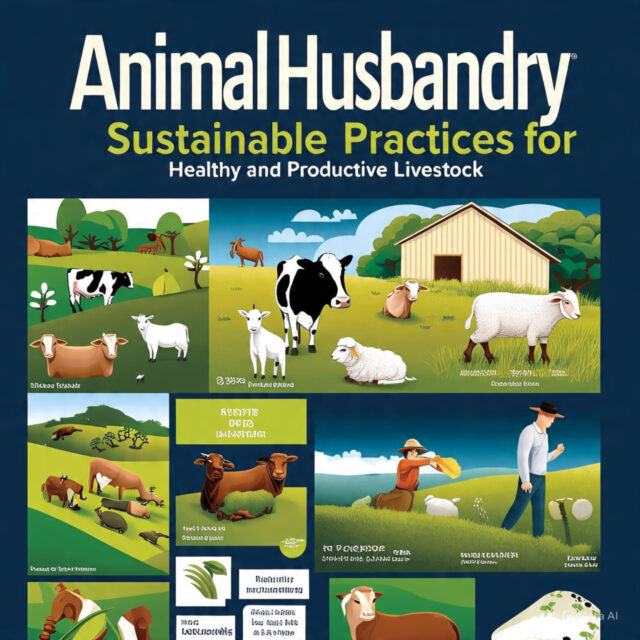
Introduction
Animal husbandry is the branch of agriculture focused on breeding, raising, and caring for livestock, including cattle, sheep, goats, poultry, and other domesticated animals. It plays a crucial role in food production, providing milk, meat, eggs, wool, and labor for human use. Effective animal husbandry involves scientific management techniques that ensure livestock health, productivity, and sustainability.
1. Selection and Breeding
Breeding is fundamental in animal husbandry as it determines the quality, productivity, and resilience of livestock. There are two primary types of breeding:
- Selective Breeding: Farmers choose animals with desirable traits such as high milk yield, rapid growth, disease resistance, and strong physique. Over generations, selective breeding enhances genetic quality.
- Crossbreeding: This involves mating animals from different breeds to combine their best traits. For example, crossbreeding indigenous cows with exotic breeds can improve milk production while maintaining resistance to local diseases.
- Artificial Insemination (AI): A modern technique where semen from high-quality males is collected and artificially introduced into females, ensuring superior offspring. AI increases genetic diversity and prevents the spread of hereditary diseases.
Breeding programs are essential for maintaining livestock populations and improving their economic value.
2. Housing and Shelter
Providing proper housing ensures the well-being and productivity of animals. Some key aspects of animal housing include:
- Ventilation and Space: Animals require well-ventilated shelters with enough space to move freely. Overcrowding can lead to stress and disease.
- Protection from Weather: Animals should be shielded from extreme temperatures, rain, and strong winds. Proper insulation and shade are necessary.
- Drainage and Waste Disposal: Floors should be slightly sloped for easy drainage. Regular cleaning of sheds prevents disease outbreaks.
- Specialized Housing: Dairy cows require milking parlors, poultry need coops with nesting areas, and sheep or goats benefit from raised platforms to stay dry.
Good housing reduces stress, enhances productivity, and prevents illness.
3. Feeding and Nutrition
A balanced diet is crucial for animal growth, reproduction, and productivity. Proper feeding involves:
- Types of Feed:
- Green Fodder (grass, leaves, silage) – Provides fiber and essential nutrients.
- Dry Fodder (hay, straw) – Ensures proper digestion and energy supply.
- Concentrates (grains, oilseeds) – Rich in proteins and fats to enhance growth.
- Mineral Supplements – Prevents deficiencies leading to disorders like weak bones or reduced fertility.
- Adequate Water Supply: Fresh, clean water is essential for digestion, milk production, and thermoregulation.
- Feeding Schedule: Animals should be fed at regular intervals to maintain metabolism and prevent overfeeding-related diseases.
Proper nutrition directly influences the quality and quantity of livestock products.
4. Healthcare and Disease Management
Livestock health management is essential to prevent economic losses and ensure animal welfare. Key aspects include:
- Vaccination Programs: Regular vaccinations prevent deadly diseases such as Foot and Mouth Disease (FMD), Brucellosis, Anthrax, and Newcastle Disease.
- Deworming: Parasites like worms can weaken animals, leading to malnutrition and reduced productivity. Deworming should be done periodically.
- Regular Veterinary Check-ups: Routine health examinations help detect illnesses early and provide timely treatment.
- Quarantine for New Animals: New livestock should be kept separate for a few weeks before integrating them into the herd to prevent disease transmission.
- Hygiene and Sanitation: Clean living conditions reduce the risk of bacterial infections and infestations.
A well-implemented healthcare plan improves livestock longevity and performance.
5. Reproduction and Calving Management
Reproduction management ensures a steady supply of livestock and prevents complications during birth. Important practices include:
- Monitoring Estrus Cycles: Knowing the best time for mating or artificial insemination increases pregnancy success rates.
- Pregnancy Care: Proper nutrition and reduced stress during gestation help ensure healthy offspring.
- Calving/Birthing Assistance: Farmers should be prepared to assist in difficult births and seek veterinary help if needed.
- Postnatal Care: Newborn animals require immediate feeding (colostrum) to build immunity and protection from harsh weather.
Efficient reproductive management leads to a sustainable and profitable livestock business.
6. Waste Management and Sustainability
Proper disposal and utilization of animal waste can prevent environmental pollution and enhance farm productivity. Sustainable waste management practices include:
- Manure Utilization: Animal manure is an excellent organic fertilizer that enriches soil fertility.
- Biogas Production: Livestock waste can be processed in biogas plants to produce clean energy for cooking and lighting.
- Composting: Solid waste can be composted to create nutrient-rich soil amendments.
- Wastewater Management: Proper drainage and treatment of wastewater prevent contamination of water sources.
Integrating waste management into farming operations promotes environmental conservation and efficiency.
7. Ethical and Sustainable Practices
Ethical animal husbandry focuses on humane treatment, sustainability, and long-term benefits. Key principles include:
- Preventing Animal Cruelty: Avoiding overexploitation and ensuring stress-free handling.
- Sustainable Farming Methods: Reducing the use of antibiotics, hormones, and harmful chemicals.
- Preserving Indigenous Breeds: Protecting native breeds to maintain biodiversity and adaptability to local environments.
- Rotational Grazing: Allowing pastures to recover by rotating grazing areas, preventing overgrazing and land degradation.
Adopting sustainable and ethical practices ensures a balanced approach to livestock management and environmental conservation.
Conclusion
Animal husbandry is a vital component of agriculture, influencing food security, rural livelihoods, and economic growth. Proper livestock management through selective breeding, adequate housing, balanced nutrition, healthcare, reproduction monitoring, and waste management enhances productivity and sustainability. Ethical and eco-friendly practices further promote long-term success.
With advancements in science and technology, modern animal husbandry continues to evolve, offering improved efficiency and better welfare for animals. By implementing best practices, farmers can ensure profitable and responsible livestock management for future generations.


Simran jeet Singh1, and Sudhir Kumar 2
1PG Scholar, Department of Veterinary Medicine,
2AssistantprofessorDepartment ofVeterinary Physiology and Biochemistry
1,2 College of Veterinary and Animal Sciences, GB Pant University of
Agriculture and Technology, Pantnagar, Udhamsingh Nagar, Uttarakhand- 263145

















